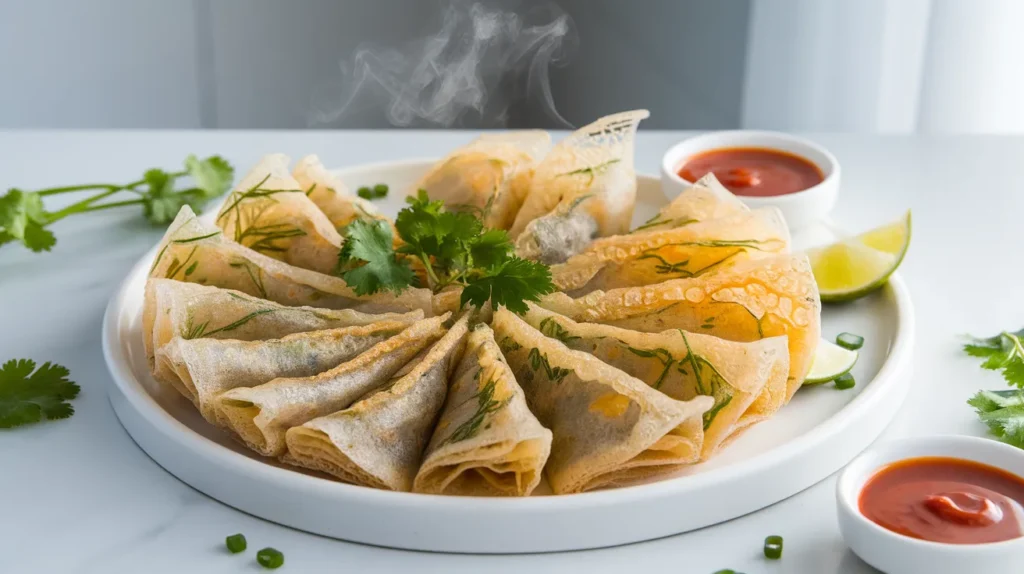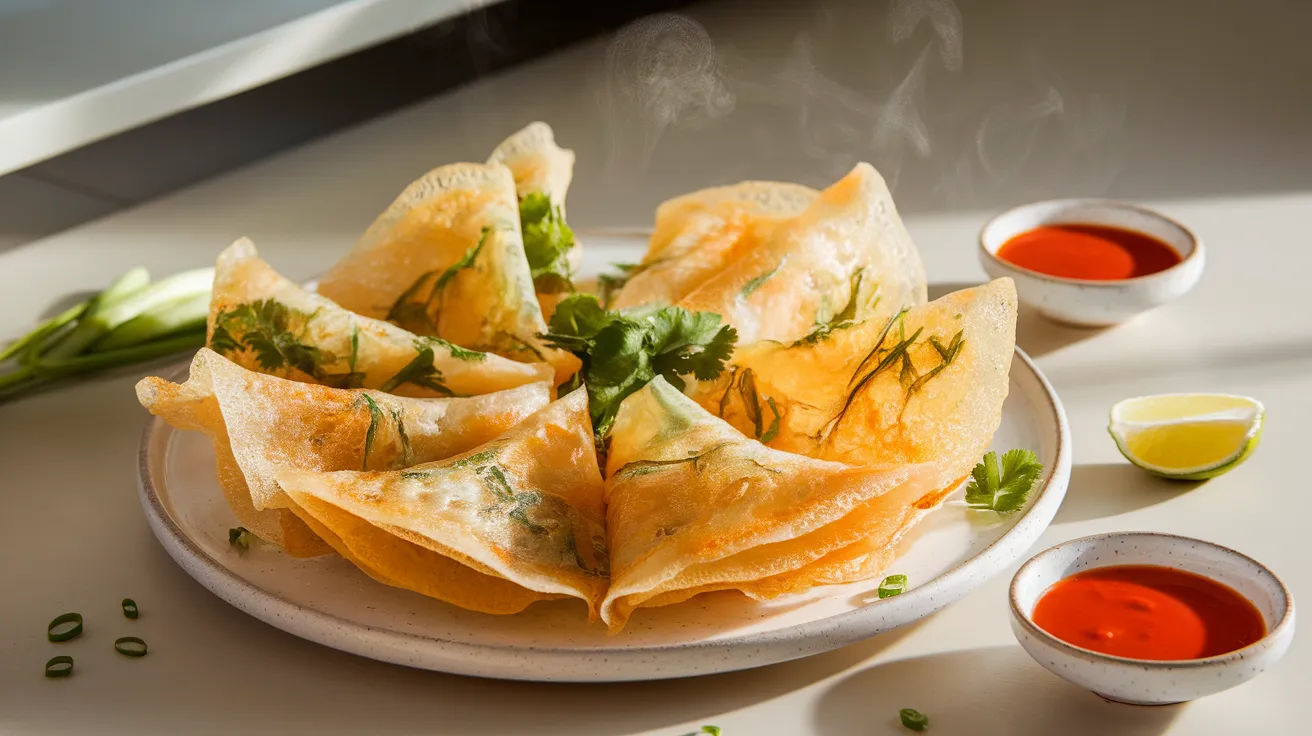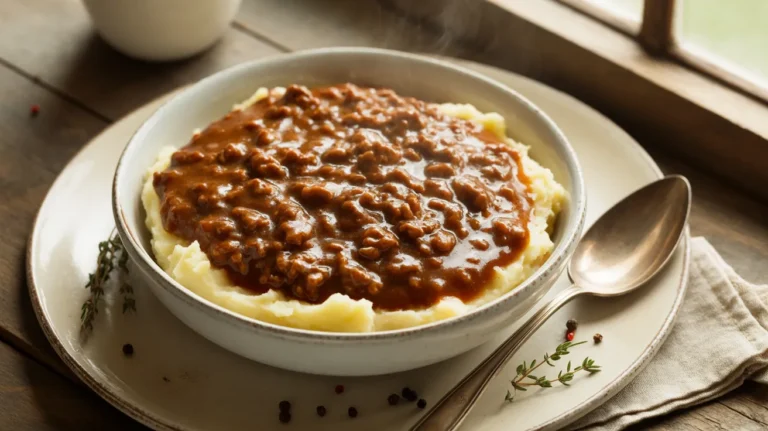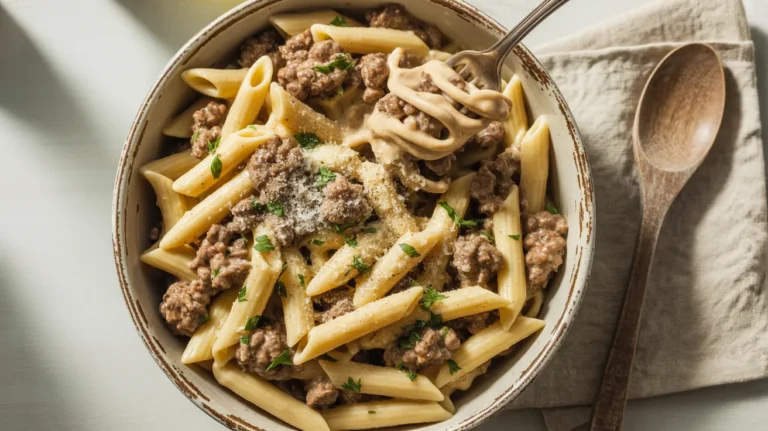Experience the delicate crunch and versatility of rice paper pancakes – a unique twist on traditional breakfast fare that transforms simple rice paper into golden, crispy delights. These rice paper pancakes offer a gluten-free alternative that’s surprisingly satisfying and endlessly customizable for your morning meal.
SERVES: 4 | PREP: 15 MIN | COOK: 12 MIN | TOTAL: 27 MIN
Ingredients
Base Pancake Components
| Ingredient | Amount |
|---|---|
| Round rice paper sheets (22cm) | 8 sheets |
| Large eggs | 3 whole |
| Coconut milk (canned) | 1/2 cup |
| Green onions, finely chopped | 3 stalks |
| Fresh cilantro, chopped | 1/4 cup |
| Garlic powder | 1/2 teaspoon |
| Salt | 1/4 teaspoon |
| White pepper | 1/8 teaspoon |
For Cooking & Serving
| Item | Amount |
|---|---|
| Vegetable oil | 3 tablespoons |
| Sesame oil | 1 teaspoon |
| Sweet chili sauce | For serving |
| Lime wedges | 4 pieces |
Step-by-Step Instructions
Phase 1: Preparation (5 minutes)
Step 1: Fill a large shallow bowl with warm water (not hot, as this will make the rice paper too soft). The water should feel comfortably warm to your touch – similar to a warm bath temperature.
Step 2: Crack the eggs into a medium mixing bowl and whisk vigorously for 30 seconds until completely smooth. This creates the binding agent that holds everything together.
Step 3: Add coconut milk to the whisked eggs, stirring gently. The coconut milk adds richness and helps create a tender texture inside the crispy exterior.
Step 4: Mix in seasonings – garlic powder, salt, and white pepper. Stir until evenly distributed. White pepper provides warmth without visible specks.
Phase 2: Rice Paper Preparation (8 minutes)
Step 5: Soften the first rice paper sheet by dipping it in warm water for exactly 10-15 seconds. It should feel pliable but still have some firmness – not completely soft. This timing is crucial for the right texture.
Step 6: Lay the softened sheet on a clean, dry cutting board. Gently pat with a clean kitchen towel to remove excess water. Too much moisture will prevent proper crisping.
Step 7: Brush egg mixture evenly across the entire surface using a pastry brush or spoon. Cover completely but don’t oversaturate – you want a thin, even layer.
Step 8: Sprinkle chopped green onions and cilantro over half the rice paper sheet. This creates flavor pockets throughout the pancake.
Step 9: Fold the rice paper in half, creating a half-moon shape. Press edges gently to seal, but don’t press too hard as this can tear the delicate paper.
Step 10: Repeat the process with remaining rice paper sheets. Work efficiently, as prepared sheets shouldn’t sit too long before cooking.
Phase 3: Cooking Process (12 minutes)
Step 11: Heat a large non-stick skillet over medium heat. Add 1 tablespoon of vegetable oil and let it shimmer – this indicates the proper temperature for crisping without burning.
Step 12: Cook 2-3 rice paper pancakes at a time, depending on pan size. Don’t overcrowd, as this reduces temperature and prevents proper crisping.
Step 13: Cook for 2-3 minutes on the first side without moving them. You’ll hear gentle sizzling – this is the rice paper crisping. Look for golden-brown edges as your visual cue.
Step 14: Flip carefully using a wide spatula. The rice paper is delicate, so support the entire pancake during flipping. Cook another 2-3 minutes until both sides are golden and crispy.
Step 15: Transfer to a wire rack or paper towel-lined plate. This prevents steam from making the bottom soggy while you finish cooking the remaining pancakes.
Step 16: Add fresh oil between batches and adjust heat if pancakes are browning too quickly. Consistent temperature ensures even cooking.
Phase 4: Final Assembly (2 minutes)
Step 17: Drizzle with sesame oil while still warm – the heat helps the sesame flavor penetrate the crispy surface.
Step 18: Cut each pancake into wedges using kitchen shears or a sharp knife. Cutting while warm prevents cracking.
Step 19: Arrange on serving plates with sweet chili sauce and lime wedges. The acid from lime brightens the rich flavors.
Step 20: Serve immediately while the exterior remains crispy. These rice paper pancakes are best enjoyed fresh from the pan.
Chef’s Notes
Texture Control: The key to perfect rice paper pancakes lies in the soaking time. Under-soaked sheets will crack during folding, while over-soaked ones become mushy and won’t crisp properly.
Flavor Layering: Consider these rice paper pancakes as a canvas for flavors. The neutral rice paper absorbs the egg mixture beautifully, while herbs add freshness and complexity.
Heat Management: Medium heat ensures the rice paper develops that signature golden crispiness without burning. Too high heat creates tough, chewy textures instead of the desired light crunch.
Make-Ahead Strategy: Prepare the egg mixture and chop herbs the night before. Fresh rice paper pancakes must be assembled and cooked fresh, but having components ready speeds the morning process significantly.
Nutrition Information (Per Serving)
- Calories: 185
- Protein: 8g
- Carbohydrates: 22g
- Fat: 7g
- Fiber: 1g
- Sodium: 320mg
Creative Variations
Savory Breakfast Style: Add crumbled bacon, diced bell peppers, and shredded cheese to the egg mixture for a heartier morning meal. This variation pairs beautifully with the technique used in our fluffy pumpkin pancakes for a complete breakfast spread.
Thai-Inspired Version: Include minced lemongrass, Thai basil, and a touch of fish sauce in the egg mixture. Serve with sriracha mayo for an authentic Southeast Asian breakfast experience.
Sweet Breakfast Adaptation: Replace savory herbs with vanilla extract and a pinch of cinnamon. Serve with honey and fresh berries for a dessert-like morning treat.
Protein-Packed Alternative: Add cooked shrimp, crab meat, or shredded chicken to create substantial rice paper pancakes. These work excellently alongside grain-based options like our nutritious sorghum pancakes for variety.
Storage & Reheating
Immediate Storage: Rice paper pancakes are best consumed immediately after cooking. However, if you must store them, place on a wire rack at room temperature for up to 2 hours.
Refrigeration: Store cooled pancakes in an airtight container for up to 2 days. Place parchment paper between layers to prevent sticking.
Reheating Method: Reheat in a 375°F oven for 3-4 minutes to restore crispiness. Avoid microwaving, which makes them chewy and tough.
Freezing Options: These don’t freeze well due to the delicate rice paper texture. Always prepare fresh for best results.

Troubleshooting Guide
Problem 1: Rice Paper Tears During Folding
Solution: Your rice paper is likely over-soaked. Reduce soaking time to 8-10 seconds and work more gently during handling.
Problem 2: Pancakes Won’t Get Crispy
Solution: Ensure your pan is properly preheated and you’re using enough oil. Excess moisture from under-dried rice paper also prevents crisping.
Problem 3: Egg Mixture Slides Off Rice Paper
Solution: Pat rice paper completely dry before adding egg mixture, and ensure the paper has the right pliable texture – not too wet or too dry.
Problem 4: Uneven Cooking or Burning
Solution: Your heat is too high. Reduce to medium-low and allow more time for even cooking. Rice paper pancakes need gentle, consistent heat.
Problem 5: Bland Flavor Throughout
Solution: Increase seasoning in the egg mixture and ensure even distribution. Don’t forget the finishing touches of sesame oil and lime.
Equipment Essentials
Large Non-Stick Skillet: Essential for even cooking and easy flipping without sticking or tearing.
Wide Shallow Bowl: For soaking rice paper sheets evenly and efficiently.
Pastry Brush: Ensures even distribution of egg mixture across the rice paper surface.
Wide Spatula: Supports the entire pancake during flipping, preventing tears.
Kitchen Shears: Best tool for cutting finished pancakes without cracking the crispy surface.
Wire Cooling Rack: Prevents steam buildup that would soften the crispy bottom.
Shopping List
Asian Market Section
- Round rice paper sheets (22cm diameter)
- Sesame oil
- Sweet chili sauce
Dairy Section
- Large eggs
- Canned coconut milk
Produce Section
- Fresh green onions
- Fresh cilantro
- Fresh limes
Pantry/Spice Aisle
- Vegetable oil
- Garlic powder
- Salt
- White pepper
Success Secrets
1. Temperature Precision: Water temperature for soaking should be warm, not hot. Hot water over-softens the rice paper, leading to tears and poor texture.
2. Timing Excellence: Work efficiently once you start soaking rice paper. The sheets continue softening even after removal from water, so immediate assembly is crucial.
3. Oil Management: Fresh oil for each batch ensures consistent crisping. Reused oil at different temperatures creates uneven cooking results.
4. Visual Cues Matter: Golden-brown edges indicate proper crisping. Don’t flip too early – patience creates the perfect texture contrast.
5. Serve Immediately: Rice paper pancakes lose their signature crispiness quickly. Plan your timing so they go from pan to plate to mouth for the ultimate experience.




